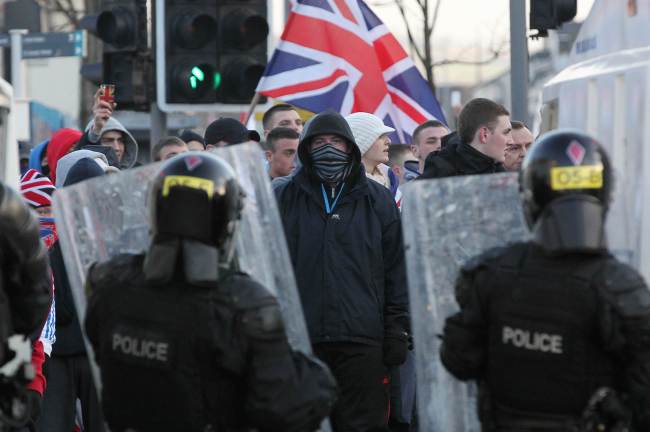DUBLIN (AP) ― Northern Ireland police fought day-and-night street battles with Protestant militants Saturday as a protest march to Belfast City Hall degenerated into riots when many marchers returned home to the Protestant east side.
The Protestants, who have blocked streets daily since Catholics on the council decided Dec. 3 to curtail the flying of the British flag, have frequently clashed with police in hopes of forcing politicians to overturn the decision.
The street confrontations have stirred sectarian passions, particularly in Protestant east Belfast and its lone Catholic enclave, Short Strand, flashpoint for the most protracted rioting over the past six weeks.
 |
Police in riot gear try to contain Union Flag-waving loyalist protesters during clashes in east Belfast, Northern Ireland, Saturday. (AFP-Yonhap News) |
Saturday’s violence began as police donning helmets, shields and flame-retardant suits tried to shepherd the British flag-bedecked crowd past Short Strand, where masked and hooded Catholic men and youths waited by their doors armed with Gaelic hurling bats, golf clubs and other makeshift weapons.
The two sides began throwing bottles, rocks and other missiles at each other and, as police on foot struggled to keep the two sides apart, Protestant anger turned against the police.
Police marched down the street with shields locked, backed by blasts from three massive mobile water cannons. Officers also fired at least a half-dozen baton rounds ― blunt-nosed, 2.5-centimeter-thick cylinders colloquially known as plastic bullets ― at rioters.
Police commander Mark Baggott said 29 of his officers were injured in the two operations, bringing total police casualties above 100 since the first riots outside city hall on Dec. 3.
The clashes have cost Northern Ireland an estimated $40 million in lost trade and tourism and in police overtime bills.
Baggott described Saturday’s police deployment as “a difficult operation dealing with a large number of people determined to cause disorder and violence.” He credited his officers with “exceptional courage and professionalism.”
The Protestant hard-liners, however, have accused police of pursuing heavy-handed tactics that have worsened the riots. Police have provided no casualty figures for civilians, who often avoid hospital treatment so that they are not identified as rioters and arrested. More than 100 rioters have been arrested since Dec. 3. The Associated Press photographer in Belfast, Peter Morrison, suffered serious injuries to his head and hand when clubbed by policemen on Dec. 3 outside city hall.
The Irish nationalist Sinn Fein party said 10 Short Strand homes were damaged during Saturday’s clashes. Sinn Fein councilman Niall O Donnghaile, who represents Short Strand, said it was the 15th illegal Protestant march past the Catholic enclave since last month. He said the marchers clearly wanted to attack Short Strand residents.
“People do not come to ‘peaceful protests’ armed with bricks, bottles, golf balls and fireworks,” O Donnghaile said of the Protestant marchers.
Belfast used to have a strong Protestant majority, but the Dec. 3 vote demonstrated that Catholics have gained the democratic upper hand, stoking Protestant anxiety that one day Northern Ireland could be merged with the Republic of Ireland as many Catholics want.
Sinn Fein council members had wanted to remove the British flag completely from city hall, where the Union Jack had flown continuously for more than a century. But they accepted a compromise motion that would allow the U.K. flag to be raised on 18 official days annually, the same rule already observed on many British government buildings throughout the United Kingdom.





![[Exclusive] Hyundai Mobis eyes closer ties with BYD](http://res.heraldm.com/phpwas/restmb_idxmake.php?idx=644&simg=/content/image/2024/11/25/20241125050044_0.jpg)
![[Herald Review] 'Gangnam B-Side' combines social realism with masterful suspense, performance](http://res.heraldm.com/phpwas/restmb_idxmake.php?idx=644&simg=/content/image/2024/11/25/20241125050072_0.jpg)

